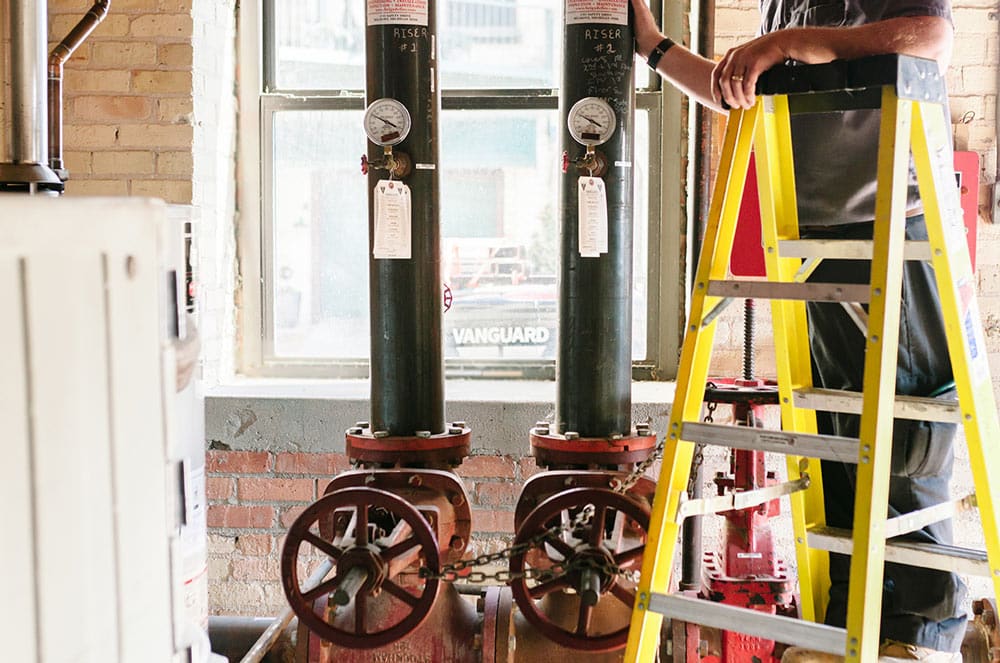All commercial buildings require fire protection — and in most cases, fire sprinkler systems are the solution that works to protect both your property and your people. If your facility has a fire sprinkler system, you may be aware that there are some situations that require it to be drained. Below, we’ll discuss when a fire sprinkler system needs to be drained, how to drain it, and what that process looks like for various types of systems.
When Does A Fire Sprinkler System Need to Be Drained?
There are a number of events that require draining your fire sprinkler system, including:
- Fire sprinkler system inspection, repairs, and maintenance
- Fire sprinkler system testing
- Restoring an activated dry-pipe system
- Extending an existing system
- Changing to accommodate new fire protection laws and regulations
How to Drain a Fire Sprinkler System
Improper draining can lead to sprinkler components being damaged. Therefore, it’s important to know each step of the process in order to make sure your fire sprinkler system is drained safely and effectively. For the best results, adhere to the following steps:
Notify Appropriate Parties
Before anything else, you should notify various parties of your plan to drain, how long it’s expected to take, and what precautionary measures you’re taking while your fire sprinkler system’s service is restored. Some important groups to notify include:
- Your insurance agent
- Your local fire department
- Your facility’s emergency response team
- Your employees
And anyone else that may be involved in or affected by your fire sprinkler system being off for any period of time.
Know Your Fire Sprinkler System’s Drain Locations and Where They Flow
The next critical step in the draining process is knowing where your fire sprinkler drains are located. Most fire sprinkler systems have three types of drains: the main drain, the test drain, and the auxiliary drains.
- The main drain is located at your fire sprinkler system’s riser.
- The test drain is usually located at the end of your fire sprinkler system.
- The auxiliary drain is located wherever your fire sprinkler system’s pipes change direction.
Once you’ve found your drains, it’s also important to figure out where they flow, or where the water goes after your system discharges. This can help you determine if you need to reroute the flow in order to protect against damage in critical areas of your property.
Draining Your Fire Sprinkler System: Wet vs. Dry Sprinkler Systems
As you may know, the two most common types of fire sprinkler systems are wet and dry. A wet fire sprinkler system always has water in the piping, and is activated whenever the system is triggered by heat. On the other hand, a dry fire sprinkler system is filled with compressed air, and only fills with water when the system is triggered.
Because they operate differently, each of these systems have different protocols for draining. We’ll walk you through them both.
Wet Fire Sprinkler System Draining Process
- Close all sprinkler control valves.
- Tag all closed valves.
- Open the main drain valve and auxiliary drain valves and let the system drain.
- Once the water is done draining, close the main drain valve and auxiliary drain valves.
- Check for any water trapped at low points in the piping that lack auxiliary drains. Remove that piping so it can drain, then replace it.
- Remove water from valve pits.
- Open all the previously tagged closed sprinkler control valves.
Dry Fire Sprinkler System Draining Process
- Close both valves at the system’s auxiliary drains if they’re not already closed.
- Remove the plug in the bottom valve, and place a container there to capture drained water.
- Open the top valve slowly until it’s completely open, then let any water drain out.
- Close the bottom valve.
- Repeat steps 3-4 until no additional water drains out.
- Close the bottom valve, then slowly open the top valve, and replace the plug.
Get Fire Sprinkler System Draining Help From a Professional
In the case that you need to drain your fire sprinkler system, it’s always best to ask a professional sprinkler service or fire protection company for help. They’re experts in each of these processes, and they can make sure everything is drained properly without any harm to your system.
Been some time since your fire sprinkler system has seen service or maintenance? Get in touch with the experts at Vanguard!


